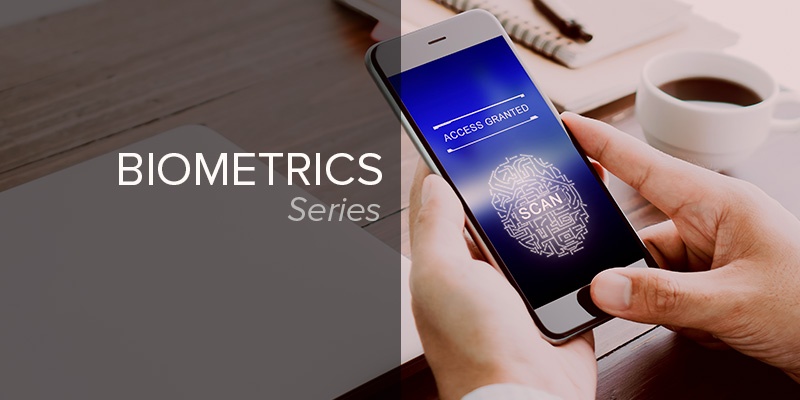
Note: this post was updated on June 2023 with new information on the latest biometrics capabilities
We recently finished our series on artificial intelligence and its multitude of uses in physical security. A natural segue is moving into biometrics and how advances in AI are making its use for access control, identification, and authentication increasingly popular.
The word biometrics can be studied in two parts: bio, relating to biology or the study of life and living organisms; and metrics, or the rule-based system of measuring data for comparative and tracking purposes. Interestingly, biometric solutions bring together qualitative and quantitative factors.
The dictionary definition of biometrics is, “the measurement and analysis of unique physical or behavioral characteristics especially as a means of verifying personal identity.” Unique physical features can mean anything from fingerprints and facial features to speech and keystroke patterns.
Biometrics have been around for a long time. There’s evidence cave dwellers used handprints as a form of “signing” their paintings on cave walls and as early as the late 14th century Chinese parents were using palms and footprints to distinguish young children from each other. In the late 1800s, law enforcement and courts began to see fingerprints as useful forensic tools for solving crimes.
It wasn’t until the development of computers with large, easily searchable databases that biometrics began to take off. Advanced computer technology allowed the collection of large amounts of biometric information that could be easily accessed and analyzed.
Other factors that helped boost the popularity of biometrics include:
- Password vulnerabilities – Passwords are not only difficult for people to remember, but unlike biometrics, they can also be easily shared or hacked. According to a recent survey, passwords account for 81 percent of data breaches.
- Biometric-enabled mobile devices – The proliferation of biometrics in smartphones and mobile devices has been a real driver for the biometric market. For instance, a study by Juniper Research shows that facial recognition hardware grows over 50% each year and that facial recognition software will be present on 1.3 billion devices by 2024.
Here are some biometric technologies used most frequently today:
Fingerprint
This biometric modality was given a big leg up by Apple and other mobile smartphone manufacturers
Facial recognition
There has been a big jump in this technology. Again, mobile device makers, such as Google's Pixel 2, have adopted the technology while the use of AI and machine learning has made it more reliable.
Facial measurements also include ear geometry, nose and head size and shape, eye distance, and even hair color.
Iris recognition technology
Considered the most accurate of the biometric technologies, iris recognition is non-invasive, non-contact, and very fast.
Physiological and behavioral patterns identified
While biometric fingerprint technology is the most widely used today, many experts believe there will be rapid growth in both facial recognition and iris recognition as costs continue to come down.
Plus, there are other physiological measurements gaining traction. For instance hand geometry, palm prints, DNA or the analysis of the genetic sequence, blood type, vein patterns in hands and eyes, and heartbeat recognition.
On the behavioral side, biometrics can identify people by their:
- Voice
- Walking gait
- Keystroke dynamics and rhythm on a keyboard
- Gestures
- Purchasing habits
- Web navigation patterns, such as scrolling and swiping
- GEO location and IP address
It is important to note that a biometric template is not stored as a picture, but rather as a sequence of code describing with accuracy the specific biometric feature. This data is stored and used as a key to unlock access if there is a match.
As biometric technology prevents patterns from being re-engineered, they can be successfully used to prevent hacking and data breaches. In physical security, they are utilized for effective access control, authentication, and verification purposes in the financial, healthcare, transportation, and government sectors.
Some of the most powerful reasons to switch to biometric access control are:
- Individuality — Biometric features are always linked to a single person, which mitigates the risk of being used without authorization like a password would.
- Convenience — Nothing compares to the comfort of opening a door or accessing an area without having to remember or carry anything.
- Security — Automatically recognizing and confirming the identity of an individual with biometrics is a fast, distinctive, discreet, and reliable way of protecting access to assets or information, making this technology highly fraud resistant.
- Accountability — Since data is highly accurate, a particular event or action can be directly connected to a specific user, increasing responsibility and awareness.
- Faster access — Typing a password takes longer than simply scanning the requested facial feature to unlock a door.
Unlike keys, IDs, proximity cards, or passwords, biometrics can’t be stolen or lost, making them a valuable tool for enhancing physical security. And when you get a custom-designed solution to fit your business security needs and combine the benefits with digital security features you get an end-to-end technology that can work throughout your organization giving people secure access to both physical and digital assets.
Contact us
Let us know how we can help your company become a safer environment.
We are here to address your organization's commercial electronic security concerns.
